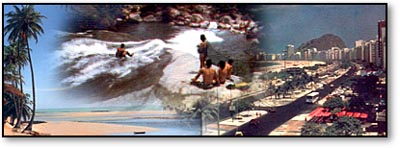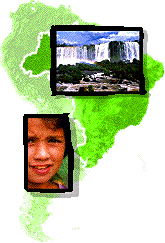
Introduction
|
 Brazil
shares a border with almost every other country in South America--only
Chile and Ecuador are untouched--and covers almost half the continent. It
is the fifth largest country in the world, behind Russia, Canada, China,
and the U.S.A., with an area of eight and a half million square
kilometers.
Brazil
shares a border with almost every other country in South America--only
Chile and Ecuador are untouched--and covers almost half the continent. It
is the fifth largest country in the world, behind Russia, Canada, China,
and the U.S.A., with an area of eight and a half million square
kilometers.
Despite its vast expanse of territory, Brazil's population is concentrated
in the major cities of its coast. The urban sprawls of Rio de Janeiro and
Sao Paulo dominate the southern coast. Further north, towns such as
Salvador and Joćo Pessoa retain the colonial atmosphere of the early
Portuguese settlers. The great interior, much of which is covered by the
rainforest basin of the Amazon, remains sparsely settled.
Almost half of Brazil's territory is covered by the basin of the Amazon
River and its tributaries, a region that is one of the world's largest
rainforest ecologies. Unfortunately, a substantial proportion
of this area has suffered the effects of modernization in recent years.
From the Amazon's mouth on the Pacific to Manaus, the region's bustling
main city, the river is heavily traveled, and wildlife is scarce. Away
from the cities and the main course of the Amazon, however, smaller
tributaries lead past unspoiled habitat and traditional villages.
South of the Amazon region, the country's interior is dominated by the
Brazilian Shield, an expansive bedrock flat that is slowly falling victim
to the elements. The Mato Grosso, a smooth, grassy plain in Brazil's
center, slowly gives way to the Planalto, a low-rise plateau that extends
across the central and western regions. In the far west, along the border
with Paraguay and Bolivia, is the Pantanal, one of the most extensive
swamplands in the world.
Brazil's winter lasts from June to August, with temperatures between 13
and 18C, but it only gets really cold south of Rio. Summer is from
December to February, a period frequently bringing stifling humidity to
the far south. Brief rain showers are common, given Brazil's tropical
climate, but the dry interior has only a few months of heavy rainfall a
year. Of course, the Amazon Basin is the wettest area, with damp, moist
temperatures averaging 27 C.
 .
.